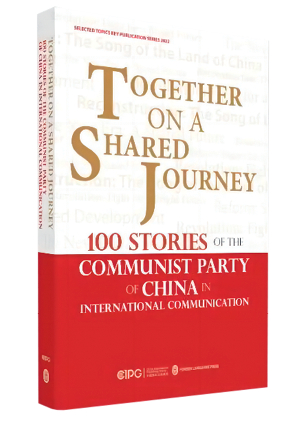
Together on a Shared Journey
— 100 Stories of the Communist Party of China in International Communication
Editors-in-Chief: Qi Yu, Du Zhanyuan
Price: RMB 138
Paperback, 397 pages
Published by Foreign Languages Press
At the press center for the 20th National Congress of the Communist Party of China (CPC), the book titled Together on a Shared Journey — 100 Stories of the Communist Party of China in International Communication attracted the attention of both Chinese and foreign journalists.
Since the founding of the CPC in 1921, many foreigners have come to China. Many touching moments and heartwarming stories about them were recorded in this book, making it a must-read in understanding the CPC’s interactions with the rest of the world.
The book has four chapters altogether: Revolution: Fight for a Bright Future; Reconstruction: The Song of the Land of China; Reform: Shared Development; and The New Era: A Shared Future.
In the first chapter, there appear many foreign names familiar to Chinese people, including Edgar Snow, Helen Foster, Anges Smedley, Anna Louise Strong, Israel Epstein, and Harrison Forman. They were the first group of Western journalists who visited Yan’an in Shaan’xi Province during the revolutionary era to report about the CPC.
In October 1937, a book written by one of those journalists became an instant hit after its debut in London, with more than 100,000 copies sold within just a few weeks. That book was Red Star Over China by Edgar Snow, the American journalist who first introduced the CPC to the world. Snow’s book triggered a China craze in Europe and the U.S. Many Western journalists as a result began dreaming about going to China, a country under the “red star.”
In May 1944, a group of Chinese and foreign journalists managed to break through the information blockade imposed by the Kuomintang (KMT) and gained authorization to visit Yan’an, the revolutionary base of the CPC. They interviewed local people and soldiers and saw Yan’an with their own eyes. Then on September 1, 1944, the Xinhua News Agency sent its first English dispatch to the world from Yan’an. From then on, the world started to hear the voice of the CPC from Western journalists. Behind this groundbreaking dispatch were the tireless efforts of Israel Epstein, who set his foot on the ground of Yan’an as a correspondent of the United Press International. He later joined the CPC in 1964, and committed the rest of his life to telling Chinese stories to the world.
The second chapter focuses on the experiences of foreigners who were witnesses to the national development of New China and had a life-long friendship with China. Ranging from statesman and businessman, to directors, photographers, and poets, they include the former King of the Kingdom of Cambodia Norodom Sihanouk, former President of South Africa Nelson Mandela, an ice-breaker of China-U.K. Trade Jack Perry, Chilean poet and diplomat Pablo Neruda, and founder of New China’s foreign language education Isabel Crook.
The story between South Africa’s politician Nelson Mandela and China started during his early years. He loved reading books about Chinese wisdom on strategy and tactics, such as Sun Tzu’s Art of War. Later in his life, especially during the 27 years of imprisonment, the Chinese wisdom seemingly became the spiritual pillar that helped him survive. He read with great interest the Selected Works of Mao Zedong, from which he learned that a true revolutionary, having once set his goal, must work tirelessly to achieve it, be prepared for adversity and setbacks, and be able to survive and grow under even the most difficult circumstances. This had become a source of strength that boosted his confidence and morale.
The Chilean poet Pablo Neruda wrote many poems about China. A winner of the Nobel Prize in Literature, he penned many poems extolling people’s revolutions around the world throughout his lifetime.
The third chapter starts with an extraordinary historical event which took place in 1979 when then vice premier Deng Xiaoping paid an official visit to the United States, less than one month after the official establishment of diplomatic relations between the two countries. The Third Plenary Session of the 11th Central Committee of the CPC had also just concluded 37 days earlier, in which the important decision was made to shift the focus of the Party and the country to economic development.
In this chapter, stories are told about the foreign friends who contributed their share to China’s reform and opening-up endeavor. For example, Konosuke Matsushita, founder of Matsushita Electric (later renamed as Panasonic), was a supporter of China’s reform and opening-up. Impressed with Deng Xiaoping’s frank and down-to-earth manner during his visit to Japan in 1978, Matsushita promised to do everything he could to help China’s pursuit of modernization.
In the last chapter, some new faces are introduced, such as the Japanese documentary director Ryo Takeuchi. In the summer of 2020, he became popular among both Chinese and Japanese netizens. a 61-minute documentary Long Time No See, Wuhan brought him into the spotlight.
Robert Lawrence Kuhn, a leading U.S. expert on China who has been awarded the China Reform Friendship Medal, recently shared his views on this new book. “Considering China’s role in the world today, foreigners should know and appreciate the real China,” he said. Many achievements have been made by the CPC, in which the international friends have played their valuable roles. They are essentially important for the global peace and prosperity. That is what the book tries to convey with the 100 touching stories.